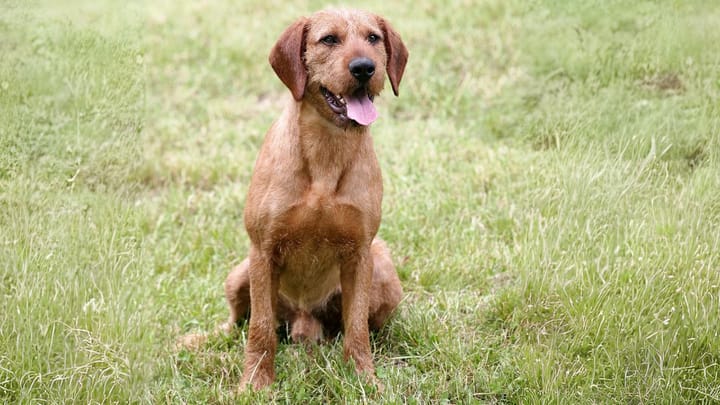Coarse-haired Styrian Hound
Other names : Styrian Coarse-haired Hound, Grande Brackes, Styrian Coarse-haired Hounds, Styrian Hounds, Wirehair Styrian Mountain Dogs, Steirische Rauhhaarbrackes, Steirische Rauhhaairge Hochgebirgsbrackes, Peintiinger Brackes

Native to Austria, the Styrian Coarse-haired Hound was initially bred to produce a dog capable of being a scent hound and to work closely with other hunting dogs over rough terrains and in challenging conditions. These hunting dogs, although highly sought after in the working field, are less known in a family environment. Although they make original family pets, they do have a very dominant side that needs to be considered.
|
Life expectancy |
The Coarse-haired Styrian Hound has a life expectancy of between 11 and 13 years |
|
Temperament |
|
|
Size |
Medium
|
|
Adult size |
Female
Between 21 and 20 in
Male
Between 19 and 21 in
|
|
Adult weight |
Female
Between 40 and 44 lb
Male
Between 40 and 44 lb
|
|
Coat colour
Red, fawn, or pale yellow. |
Red Sand |
|
Type of coat
Harsh, rough coat hair. Shorter hair on head; coat never shaggy looking. |
Hard Long |
|
Eye colour
Brown. |
Brown
|
|
Purchase price |
The Coarse-haired Styrian Hound costs between £400 and £700 |
The Styrian Coarse-haired Hound is a relatively rare dog breed. It is very rare to find puppies for sale. Because of his fantastic hunting skills and the ability to not only smell his quarry but also to give chase over harsh terrain, he is much sought after by hunting folk.
More details about the Coarse-haired Styrian Hound
Coarse-haired Styrian Hound: Origins and history
The Styrian Hound breed was initiated in Austria when a coarse-haired Istrian Hound and a Hanoverian Scenthound were mated. The finest pups from this litter were kept and from these select puppies, the Styrian Coarse-haired Hound evolved. The breed was first recognised in 2006 by the UK Kennel Club.
Physical characteristics of the Coarse-haired Styrian Hound
The Styrian Coarse-haired Hound has a body shape with a broad back and a deep chest. His muscular build allows him to hunt and run over any difficult terrains. His overall appearance is of confidence and strength. The ears hang down, lying close to the dog’s head. His eyes are medium sized, dark in colour with dark eye edging.
FCI classification of the Coarse-haired Styrian Hound
-
Group 6 - Scent hounds and related breeds
-
Section 1 : Scent hounds
Coarse-haired Styrian Hound: Characteristics
Coarse-haired Styrian Hound: Behaviour
Training a Coarse-haired Styrian Hound
This dog’s training must begin at a very young age and be consistent to emphasise to the dog exactly what you expect from him. Obedience and socialisation skills need to be taught, as this hound is quite stubborn and independent. He must understand the “recall” command, particularly when he is hunting in the field, and picks up the scent of something interesting.
Coarse-haired Styrian Hound: Lifestyle
Breed compatibility Coarse-haired Styrian Hound
Coarse-haired Styrian Hound: Purchase price
Initial purchase cost for this breed is between £400 to £700. Additional, ongoing monthly fees can amount to £80 - £100, taking into account feed, veterinary costs, and pet insurance.
Coarse-haired Styrian Hound: Shedding
Average
Copious shedder throughout the year. Shedding is particularly heavy during the Spring and Autumn seasons.
Coarse-haired Styrian Hound: Grooming
On average, weekly grooming is recommended for the Styrian Coarse-haired Hound to keep his coat hair in good condition. Grooming with a firm bristle brush is advised. Certainly, after a hunting expedition, intense brushing will be required to remove any twigs and burrs from his coat.
Coarse-haired Styrian Hound: Health
The Styrian Hound is generally a robust and healthy dog, with no reported genetic health issues to date. Common health problems that might arise, however, are ear infections, cancer, hip dysplasia and sensitivity to anaesthesia. The majority of problems will arise from hunting incidents, such as broken limbs, gun wounds and bites. The average life expectancy of this breed is 11 to 13 years.
A very hardy, strong breed. His muscular body is able to hunt his prey over even the most difficult, harsh terrain.
The robust Styrian Hound can certainly endure any discomfort, in any climate, especially when trailing his quarry.
As a dog that has been bred in the mountains of Austria, where the climate is usually very cold, the Styrian Coarse-haired Hound has no problems in chilly weather or situations.
This breed tends not to gain weight, as they are such active, high-energy dogs. However, once his working life is over and he relaxes more at home, he may start to gain weight.
- Hip dysplasia
- Cancer
- Anaesthesia sensitivity
- Bloat
- Ear infections
- Progressive retinal atrophy
- Obesity
Do you want a Coarse-haired Styrian Hound dog ?
Oh no...
There are no Coarse-haired Styrian Hound adoption profiles at the moment...

